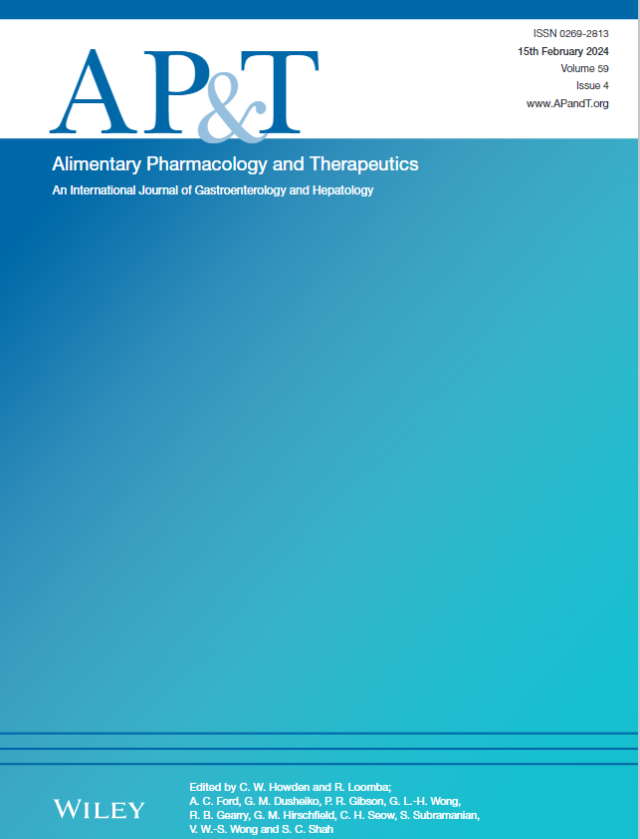Review Article: GLP-1 Receptor Agonists and Glucagon/GIP/GLP-1 Receptor Dual or Triple Agonists-Mechanism of Action and Emerging Therapeutic Landscape in MASLD.
IF 6.6
1区 医学
Q1 GASTROENTEROLOGY & HEPATOLOGY
引用次数: 0
Abstract
BACKGROUND Metabolic dysfunction-associated steatotic liver disease (MASLD) is primarily managed through diet and lifestyle modifications. However, these behavioural interventions alone may not achieve disease regression or remission, and maintaining long-term adherence is challenging. Incretin mimetics and other gastrointestinal hormones targeting the pleiotropic pathophysiological pathways underlying MASLD have now emerged as promising disease-modifying therapies. AIMS This is a comprehensive review summarising the role of glucagon-like peptide-1 (GLP-1) receptor agonists and glucagon/glucose-dependent insulinotropic polypeptide (GIP)/GLP-1 receptor dual or triple agonists in the treatment of metabolic dysfunction-associated steatohepatitis (MASH). METHODS Only clinical trials with endpoints assessed by liver histology were included for a robust evaluation of therapeutic efficacy. RESULTS Recent evidence from phase 2 clinical trials for MASH demonstrated that pharmacological agents based on GLP-1 receptor agonism are effective in improving disease activity. Additionally, tirzepatide and survodutide showed potential clinical benefits in reducing fibrosis. Other cardiometabolic benefits observed include weight loss and improvements in glycaemic control and lipid profile. Adherence to treatment may be limited by gastrointestinal side effects, though they were found to be generally mild to moderate in severity. An interim analysis of the semaglutide phase 3 trial confirmed its efficacy in improving steatohepatitis and demonstrated its potential to improve fibrosis. CONCLUSIONS GLP-1 receptor agonists, alone or in combination with GIP and/or glucagon receptor agonists, represent promising, effective pharmacotherapies for the treatment of MASLD/MASH. Larger and longer-duration clinical trials are needed to further evaluate the efficacy and safety of GIP receptor and glucagon receptor agonism.GLP-1受体激动剂和胰高血糖素/GIP/GLP-1受体双重或三重激动剂——MASLD的作用机制和新的治疗前景。
背景:代谢功能障碍相关的脂肪变性肝病(MASLD)主要通过饮食和生活方式的改变来控制。然而,仅靠这些行为干预可能无法实现疾病的消退或缓解,并且保持长期坚持是具有挑战性的。肠促胰岛素模拟物和其他胃肠道激素靶向MASLD背后的多效病理生理途径现已成为有希望的疾病改善疗法。目的:本文综述了胰高血糖素样肽-1 (GLP-1)受体激动剂和胰高血糖素/葡萄糖依赖性胰岛素多肽(GIP)/GLP-1受体双重或三重激动剂在代谢功能障碍相关脂肪性肝炎(MASH)治疗中的作用。方法:仅纳入以肝脏组织学评估终点的临床试验,以对治疗效果进行可靠评估。结果最近来自MASH 2期临床试验的证据表明,基于GLP-1受体激动作用的药理学药物可有效改善疾病活动性。此外,替西肽和利伏肽在减少纤维化方面显示出潜在的临床益处。观察到的其他心脏代谢益处包括体重减轻、血糖控制和血脂的改善。坚持治疗可能受到胃肠道副作用的限制,尽管发现它们的严重程度一般为轻度至中度。西马鲁肽3期试验的中期分析证实了其改善脂肪性肝炎的疗效,并证明了其改善纤维化的潜力。结论sglp -1受体激动剂单独使用或与GIP和/或胰高血糖素受体激动剂联合使用是治疗MASLD/MASH的有效药物治疗方法。需要更大规模和更长期的临床试验来进一步评估GIP受体和胰高血糖素受体激动剂的有效性和安全性。
本文章由计算机程序翻译,如有差异,请以英文原文为准。
求助全文
约1分钟内获得全文
求助全文
来源期刊
CiteScore
15.60
自引率
7.90%
发文量
527
审稿时长
3-6 weeks
期刊介绍:
Alimentary Pharmacology & Therapeutics is a global pharmacology journal focused on the impact of drugs on the human gastrointestinal and hepato-biliary systems. It covers a diverse range of topics, often with immediate clinical relevance to its readership.

 求助内容:
求助内容: 应助结果提醒方式:
应助结果提醒方式:


